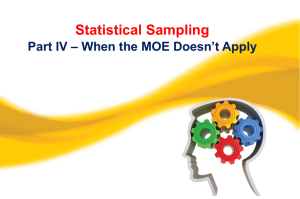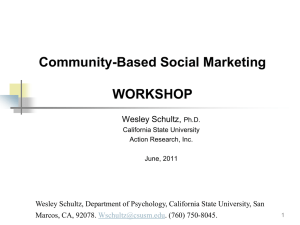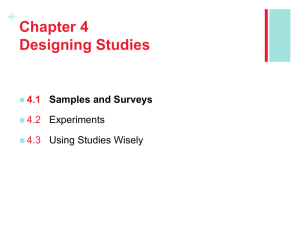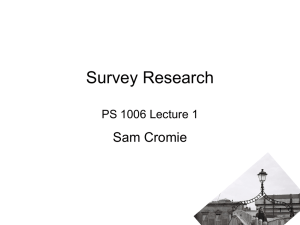Snowball sampling is a special nonprobability method used when
advertisement
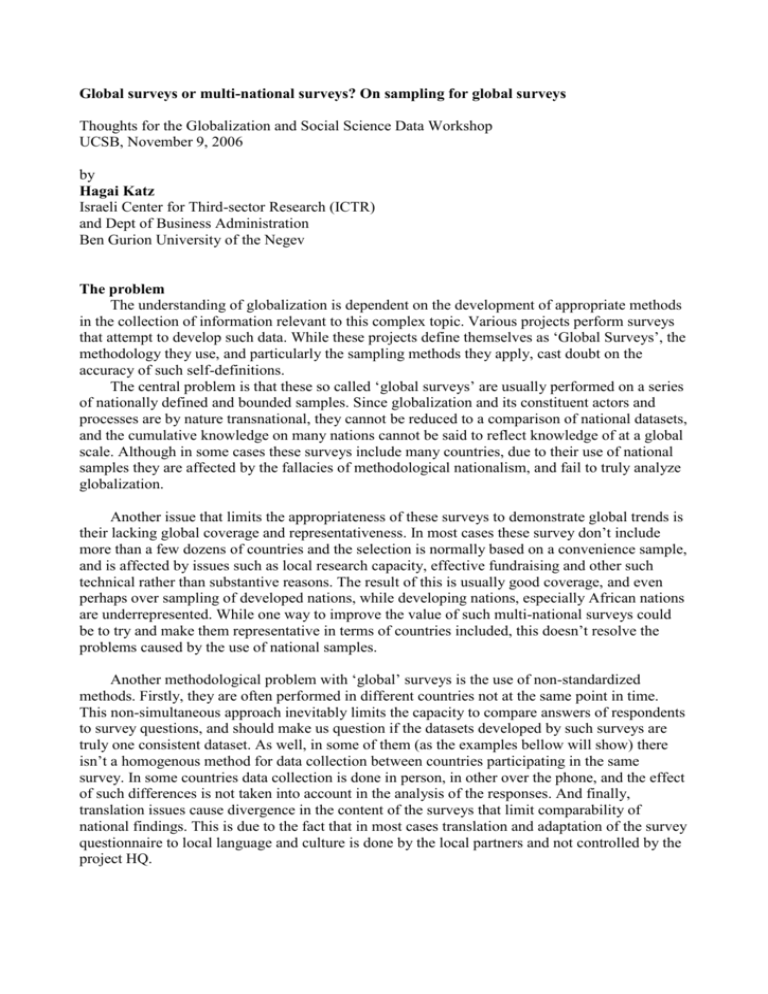
Global surveys or multi-national surveys? On sampling for global surveys Thoughts for the Globalization and Social Science Data Workshop UCSB, November 9, 2006 by Hagai Katz Israeli Center for Third-sector Research (ICTR) and Dept of Business Administration Ben Gurion University of the Negev The problem The understanding of globalization is dependent on the development of appropriate methods in the collection of information relevant to this complex topic. Various projects perform surveys that attempt to develop such data. While these projects define themselves as ‘Global Surveys’, the methodology they use, and particularly the sampling methods they apply, cast doubt on the accuracy of such self-definitions. The central problem is that these so called ‘global surveys’ are usually performed on a series of nationally defined and bounded samples. Since globalization and its constituent actors and processes are by nature transnational, they cannot be reduced to a comparison of national datasets, and the cumulative knowledge on many nations cannot be said to reflect knowledge of at a global scale. Although in some cases these surveys include many countries, due to their use of national samples they are affected by the fallacies of methodological nationalism, and fail to truly analyze globalization. Another issue that limits the appropriateness of these surveys to demonstrate global trends is their lacking global coverage and representativeness. In most cases these survey don’t include more than a few dozens of countries and the selection is normally based on a convenience sample, and is affected by issues such as local research capacity, effective fundraising and other such technical rather than substantive reasons. The result of this is usually good coverage, and even perhaps over sampling of developed nations, while developing nations, especially African nations are underrepresented. While one way to improve the value of such multi-national surveys could be to try and make them representative in terms of countries included, this doesn’t resolve the problems caused by the use of national samples. Another methodological problem with ‘global’ surveys is the use of non-standardized methods. Firstly, they are often performed in different countries not at the same point in time. This non-simultaneous approach inevitably limits the capacity to compare answers of respondents to survey questions, and should make us question if the datasets developed by such surveys are truly one consistent dataset. As well, in some of them (as the examples bellow will show) there isn’t a homogenous method for data collection between countries participating in the same survey. In some countries data collection is done in person, in other over the phone, and the effect of such differences is not taken into account in the analysis of the responses. And finally, translation issues cause divergence in the content of the surveys that limit comparability of national findings. This is due to the fact that in most cases translation and adaptation of the survey questionnaire to local language and culture is done by the local partners and not controlled by the project HQ. Let us see a few examples of ‘global’ surveys and note the problematic I just mentioned. Then we can consider a few alternative methods. The sampling in current prominent 'global' surveys In nearly all large scale so-called global surveys the sampling is based on national samples in a selection of countries, while the selection of countries is normally a convenience sample. The following are only three examples from some of the largest multi-nation surveys. The World Values Survey (as well as the related European Values Survey) is probably the largest of attitude surveys today, It has been growing continually since its first wave, and now, in its 4th wave it collects data from interviews with representative national samples in more than 80 societies on all six inhabited continents. In each country the questionnaires are administered to about 1,000 to 3,500 interviewees, with an average of about 1330 interviews per country and a worldwide total of about 92,000 interviews. Table 1 bellow lists the country coverage of the World Values Survey in its 4th wave, according to the year each country was surveyed. With such a large number of countries, the World Values Survey has quite good coverage. Nonetheless, its selection of countries is not systematic or randomized in any way, and inclusion is based on will and capacity. Thus, the representation of the various regions is not proportionate. For example, only five Latin American countries and no Caribbean nations are included. Table 1. World Values Survey 4th wave country coverage 1999 2000 2001 2002 2003 2004 Argentina , Poland , Croatia , Spain , Belgium , Greece , Latvia , Czech Rep., Italy , Malta , Netherlands , Russia , Denmark , Bulgaria , Slovakia , Iceland , Northern Ireland , Romania , Luxembourg , Austria , Ireland , Great Britain , Estonia , Slovenia , Germany , Portugal , Hungary , Lithuania , Ukraine , Sweden , United States , France Iran, Belarus , Egypt , Finland , Canada , Spain , Chile , Japan , Nigeria , Mexico , Venezuela Morocco , South Africa , Indonesia , Israel , Turkey , Montenegro , Turkey , Zimbabwe , Uganda , Bosnia and Herzegovina , Philippines , Rep. of Korea , Puerto Rico , Morocco , Pakistan , Jordan , China , Peru , India , Vietnam , Macedonia, Serbia , Tanzania Moldova , Algeria , Singapore , Albania , Bangladesh Kyrgyzstan, Saudi Arabia Iraq The Global Barometers are a series of regional multi-national surveys, such the EuroBarometer, the AfroBarometer, and the New Europe Barometer. In those surveys standardization is very limited. Questionnaires aren't always comparable, making comparative analysis a complicated task. In the AfroBarometer, for example, the surveys are face-to-face interviews by trained interviewers in the language of the respondent's choice. It uses national probability samples that represent an accurate cross section of the voting age population. Random selection is used at every stage of sampling and the sample is stratified to ensure that all major demographic segments of the population are covered. Sample size varies from a minimum of 1200 in each country to up to 2400 or more. Table 2 bellow lists country coverage by survey wave. Table 2. AfroBarometer country coverage by wave Waves Benin Botswana Cape Verde Ghana Kenya 1 1999 1999 2 2003 2002 2002 2003 3 2005 2005 2005 2005 2005 1 Mozambique Namibia Nigeria Senegal South Africa 1999 2000 2000 2 2002 2003 2003 2002 2002 3 2005 2006 2005 2005 2006 Lesotho Madagascar Malawi Mali 2000 2003 1999 2001 2003 2002 2005 2005 2005 2005 Tanzania Uganda Zambia Zimbabwe 2001 2000 1999 1999 2003 2002 2003 2004 2005 2005 2005 2005 Globescan, the research and polling company (previously Environics), conducts 'global' opinion polls. It contracts local polling firms in various countries to administer its surveys in each country, as well as to translate the original questionnaire and adapt it to the local contexts. In Globescan surveys surveying methodology varies, and in different countries surveys can be performed face-to-face or by telephone. As well, national sampling isn't uniform – in some countries samples are national, and in other they are urban and exclude rural areas, and there are also differences in the age range of the sampling frame. Globescan's largest surveys encompass at most 35 countries, with a total of approximately 42,000 respondents (Table 3). The national samples are based on the national population census as sampling frame, and use standard sampling techniques (e.g. phone book random dialing). Table 3. Globescan 35 country survey coverage Country Afghanistan Argentina Brazil Chile DR Congo Ghana India Indonesia Iran Iraq Kenya Mexico Nigeria Philippines Poland Russia Saudi Arabia Senegal N 2098 1003 800 1200 1000 1006 1452 1000 1118 2200 1005 1000 1000 1000 1026 1004 1000 1005 Method Face Face Face Face Face Face Face Face Face Face Face Face Face Face Face Face Face Face Sample 18+, National 18+, National 18-69, Urban 18+, Urban 18+, National 18+, National 18+, National 18-60, 17+, National 18+, National 18+, National 18+, National 18+, National 18+, Urban 18+, National 18+, National 18-59, National 18+, National Country South Africa Sri Lanka Tanzania Turkey Zimbabwe Australia Canada China Egypt Finland France Germany Great Britain Italy South Korea Spain United States N 3497 1012 1000 1000 1010 1026 1004 1863 1221 1069 1002 1006 1000 1015 1000 1012 1000 Method Face Face Face Face Face Phone Phone Phone Phone Phone Phone Phone Phone Phone Phone Phone Phone Sample 16+, National 18+, National 18+, National 15+, Urban 18+, National 18+, National 18+, National 18-65, Urban 18+, National 18-79, National 15+, National 16-70, National 18+, National 18+, National 19+, National 18+, National 18+, National One different survey not using national samples is the Global Stakeholder Panel. This project collects data on opinions and attitudes from a non-representative, non-random sample of individual respondents from an address database that is occasionally updated. The address research itself is thematically focused in compatibility with survey theme, and is put up using a 'normal' internet search engine. It included companies, associations, research organizations and academia, political institutions and NGOs, with no preference for any of these groups. Overall, it recently consisted of 12,186 e-mail addresses which were divided into language, as follows: English: 7,350 German: 3,935 Spanish: 475 French: 318 Chinese: 108. The survey is conducted in the language of the respondent’s choice, out of 5 languages (see figure 1 for a distribution of respondents by language). Solicitation of responses is done via direct e-mail containing a link to the questionnaire website. Hence, the GSP method uses language and not nation as the basic criteria for sampling. However, the limited scope of their database which serves as their sampling universe limits the value of their findings. It is definitely not an exhaustive listing of relevant entities, and because of that the generalizability of their findings is limited. Figure 1. Global Stakeholder Panel Distribution of R's by language Alternative sampling methods for global surveys I believe that there are some sampling methods that are especially appropriate for global surveys and for developing information on global and transnational phenomena. While these methods can resolve some of the problems that afflict national samples, they naturally have their own limitations, which we must consider. I want to offer some first thoughts to start the discussion on alternative sampling methods for the study of globalization going. These ideas try to utilize social network and GIS in the development of samples for global attitudes and opinion surveys. Snowball sampling is a special nonprobability method e for developing a research sample where existing study subjects recruit future subjects from among their acquaintances. This sampling technique is often used in hidden populations which are difficult for researchers to access (such as drug users or commercial sex workers), or in cases where a sampling frame is hard to establish and it is assumed that cases are affiliated through links that can be exploited to locate other respondents based on existing ones. Because sample members are not selected from a sampling frame, snowball samples are subject to numerous biases. For example, respondents who have many links are more likely to be recruited into the sample. It was widely believed that it was impossible to make unbiased estimates from snowball samples, but a variation of snowball sampling called respondent-driven sampling has been shown to allow researchers to make asymptotically unbiased estimates from snowball samples under certain conditions (Heckathorn 1997). Respondent-driven sampling also allows researchers to make estimates about the social network connecting the hidden population. In the study of globalization, where connectivity between persons, organizations and other entities is a core element (see Anheier and Katz, 2004), network based sampling methods can actually have a special benefit by elucidating the network structures as well as obtaining the attitudes or opinion data. Hypernetwork sampling (McPherson, 1982; Spaeth, 1985), also known as multiplicity sampling, is a multi-level method based on affiliation between entities between two different levels, such the affiliation between organizations and individuals engaged in them. The researcher draws a probability-proportional-to-size sample from one level (e.g. activists) and through them reaches the second level (e.g. organizations, obtaining names of the organizations that employ them or of the voluntary associations of which they are members). This method bypasses the effort to list a universe of the entities at the second level, relying instead on the well-developed technology for drawing representative samples at the first level. This technique was used in the National Congregations Study, based on the insight that organizations attached to a random sample of individuals constitute a random sample of organizations. It therefore is possible to generate a representative sample of organizations even in the absence of a sampling frame that comprehensively lists the units in the organizational population. -- has been used to sample both employing organizations and voluntary associations. In the case of studying globalization, it seems useful to perhaps the best way is to sample international organizations (of which good listing do exist) organizations and from them reach members, activists and other affiliated persons or organizations. Finally, geographically based sampling can be also useful in the development of global surveys. The use of national samples is a specific case of the effect of predetermined spatial boundaries on analysis. Using predefined and irregular spatial units of analysis such as national boundaries often cause bias, based on the fact the use of such (usually politically laden) geographies impose preconceptions on the data produced, often not explicitly so (see for example the discussion by Coulton and her colleagues, 2001). This is complicated by the fact that such artificial boundaries don’t always correspond to persons’ actual experience of social boundaries and regions. A way to address this problem is to use tessellation to create less value-laden geographical boundaries that can be used to generate samples instead of national boundaries. Various spatial techniques exist to do this. One is deriving area boundaries based on the actual spatial distribution of entities or actors, such as Voronoi polygons (see figure 2). An example of the use of Voronoi polygons in the study of nonprofit organizations can be found in the work of Bielfeld and Murdoch (2004). Figure 2. An example of Voronoi polygons Figure 3. Different regular tessellations This still doesn’t resolve the effect of size differences between spatial units on the weighting of responses. This is addressed by another technique which is basically to use a regular grid instead. In this technique a regular grid of square (or any other shape, see figure 3) is imposed on the study area and the analysis (or sampling) is based on these boundaries. This method suffers from the caveat that the spatial units used are not ‘real’. References 1. Anheier H.K. and Katz H. (2004). “Network Approaches to Global Civil Society”, in Anheier HK, Kaldor M and Glasius M (Eds) Global Civil Society 2004/5. London: Sage. 2. Bielefeld W. and Murdoch J.C. (2004). “The Locations of Nonprofit Organizations and Their For-Profit Counterparts: An Exploratory Analysis”. Nonprofit and Voluntary Sector Quarterly, 33 (2): 221-246. 3. Coulton C.J., Korbin J., Chan T., and Su M. (2001). Mapping Residents’ Perceptions of Neighborhood Boundaries: A Methodological Note. American Journal of Community Psychology, Vol. 29, No. 2. 4. Heckathorn D.D. (1997). "Respondent-Driven Sampling: A New Approach to the Study of Hidden Populations". Social Problems 44: 174-199 5. McPherson, J. M. (1982). Hypernetwork Sampling: Duality and Differentiation Among Voluntary Associations. Social Networks, 3, 225–249. 6. Spaeth, J. L. 1985. Multiplicity samples of organizational hierarchies. McAfee, NJ: Press of the American Association of Public Opinion Research.



